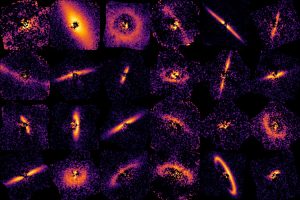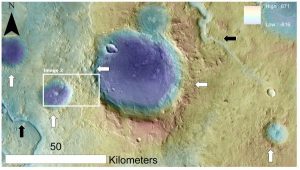Media
Transcript
Over the years I’ve read a lot of papers and press releases, and at a certain point, I honestly started to think nothing could surprise me anymore. Today, the universe proved me wrong by presenting something glorious that I could never have imagined.

The Hubble Space Telescope has imaged the changing shadow of a planetary disk on background dust and gas clouds, and like a shadow puppet of a bat, it appears to flap dark wings.
Astronomers studying the young star HBC 672 made this discovery entirely by accident. It had previously been known that the star has what has been nicknamed a “Bat Shadow” behind it in the Serpens Nebula. This shadow is cast by the star’s planetary disk, which blocks a band of light. That flapping? That is the eddy of a planet moving around the star in that disk.
This amazing change in light and shadow was seen serendipitously in data that was taken over 404 days. The team had requested images of this region in a variety of filters and because of how Hubble schedules time, these images were acquired over thirteen months. It was in trying to create a final image by combining all the data that this motion was suddenly revealed. The data wasn’t designed to study this phenomenon, so our understanding of the system is still shadowed. As best it can be measured, this newly discovered baby world is orbiting no faster than every 180 days and is about the same distance from its star as the Earth is from the Sun. This discovery carries on a recent theme that worlds form fast: this star is just one or two million years old, and already it is host to at least one world. This work was published in the Astrophysical Journal and was led by Klaus Pontoppidan.
If one thing defines astronomy in this first half of 2020, it’s our progress in observing planets and planetary forming disks. This data is reshaping how we understand planetary formation, and the data is coming at us fast and furious from all directions.
The results we’re seeing today are the result of work that started many years ago. The pace of science can be slow, with each new investigation requiring time to apply for funding, time to build the instruments, time to acquire the data, and time to do the needed analysis. As we’ve pointed out before, BepiColombo was named in 1999 and will only reach Mercury in 2021.

In planetary science, the Gemini Planet Imager has spent the last four years providing the sharpest images to date of the disks around young stars, including a newly released catalog of 26 debris disks, most of which show evidence of planets, and some of which even contain evidence of comet belts. This survey will produce new scientific understanding for years to come but has already started to make sense of some aspects of planet formation. For instance, the youngest star in this collection is also the only one not to have a hole in the center of its disk. This matches theories that say it takes time for planets to clear out the insides of solar systems, and this will start to put constraints on when things happen in solar system formation and help us understand the story of our own system’s formation.
Unfortunately, we may never understand the details of origins. This is expressed by study second author Paul Kalas, who said: If you dial back the clock for our own solar system by 4.5 billion years, which one of these disks were we? Were we a narrow ring, or were we a fuzzy blob? It would be great to know what we looked like back then to understand our own origins. That is the great unanswered question.
This work was lead by Tom Esposito and appears in the Astronomical Journal.
Our final story of the day looks back not at the history of star systems but rather at the history of Mars.

In research by a team led by Planetary Science Institute‘s own Alexis Rodriguez, there is new evidence that asteroids impacted ancient Martian glaciers and the resulting splash, for lack of a better term, drove water and dust into the Martian atmosphere. According to Rodriguez: Something unique happened on Mars during this early phase in its history – most of the planet’s impact basins formed. The formation of these gigantic structures, hundreds to two thousand kilometers in diameter, would have produced extremely powerful winds and would have also most likely triggered transient climate change conducive to rainfall. The winds could have dislodged from the surface vast volumes of dust that existed when the impacts occurred, resulting in dust-laden atmospheric conditions. We suggest that when rainfalls happened, large amounts of the dust were removed from suspension to be redeposited as thick sedimentary units.
Rodriguez goes on to explain: An interesting implication of the muddy rain hypothesis is that this process could have emplaced enormous volumes of wet sediments over the planet’s extremely cold surface environments. In the likely presence of salts, the water-soaked mud might have produced immense aquifers with low-temperature freezing brines.
Put another way, this process could have created reservoirs of salty liquid water while at the same time building up immense mudstones that we see today.
This work has a lot of cool implications for Mars’s former water cycle and even potential habitability. We’re going to invite the team members who did this work to come on as guests so they can explain this work in their own words. For now, you can check out their paper in the journal Nature Scientific Reports.
Learn More
Hubble Watches the “Flapping” of Cosmic Bat Shadow
- ESA press release
- Hubblesite press release
- “Variability of the Great Disk Shadow in Serpens,” Klaus M. Pontoppidan et al., 2020, to appear in the Astrophysical Journal (Preprint on arxiv.org)
Young Planets Bite the Dust
- Berkeley News article (UC Berkeley)
- NOIRLab press release
- “Debris Disk Results from the Gemini Planet Imager Exoplanet Survey’s Polarimetric Imaging Campaign,” T. M. Esposito et al., 2020 June 15, Astronomical Journal (Preprint on arxiv.org)
Massive Mud Downpours Might Have Formed Some of the Most Ancient Highlands on Mars
- Planetary Science Institute press release
- “The Oldest Highlands of Mars May Be Massive Dust Fallout Deposits,” J. Alexis P. Rodriguez et al., 2020 June 25, Nature Scientific Reports
Credits
Written by Pamela Gay
Hosted by Pamela Gay
Audio and Video Editing by Ally Pelphrey
Content Editing by Beth Johnson
Intro and Outro music by Kevin MacLeod, https://incompetech.com/music/


 We record most shows live, on Twitch. Follow us today to get alerts when we go live.
We record most shows live, on Twitch. Follow us today to get alerts when we go live.